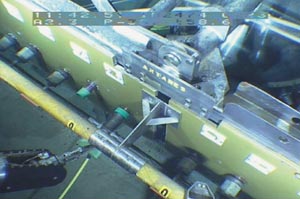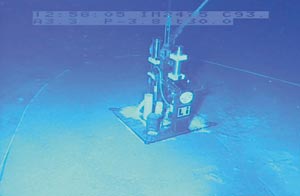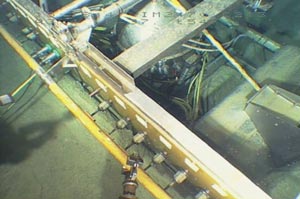A prototype ANTARES detection line is returning data after a two-day mission by the Nautile submersible to make the necessary connections on the sea-bed.

The ANTARES underwater neutrino telescope, located in the Mediterranean Sea south of l’Ile de Porquerolles near Toulon, has passed a major milestone on the way to implementation in late 2004. At around 1700 h on 17 March, 2003, the first data were received from a prototype detection line of optical modules containing photomultiplier tubes. Earlier in the mission, the Nautile manned submersible of the French IFREMER oceanographic research agency had made the vital connections from both the detection line and a second line carrying underwater environmental instrumentation to the underwater electro-optical junction box, which had been deployed in December 2002.

After navigating by fixes from a network of sea-bed acoustic transponders deployed around the ANTARES site, and then staying in place with its GPS dynamical positioning system, the Nautile‘s service ship l’Atalante had deployed a 350 m spool of electro-optical interlink cable. Around 30 minutes later, a position fix from an acoustic transponder attached to the spool confirmed that it had been accurately positioned to within 100 m of the junction box, more than 2400 m below. It was then the turn of Nautile to begin its two hour descent. On the sea floor, the submersible would use its own acoustic navigation system to triangulate within the ANTARES transponder network and recover the cable spool.

A buoy made from syntactic foam having constant buoyancy down to 2500 m depth was attached to the spool to give it a slightly negative buoyancy, allowing Nautile to carry the cable between its manipulator arms. Placing the spool within 25 m of the junction box, Nautile grasped the deep-sea “mateable” electro-optical connector containing two electrical and four fibre-optic pathways, which can be plugged and unplugged in seawater at pressures of 250 atmospheres. The cable was then unwound and plugged into one of the 16 outputs from the junction box. After shore-based measurements using optical time-domain reflectometry had verified that the light loss and reflection at the connection were within acceptable limits, Nautile recovered the cable spool and laid out the cable in the direction of the detection line’s sea anchor. Waypoint markers on this interlink cable would allow future forays into the site of the detector to be made without acoustic navigation.

During the same mission, Nautile unfurled a second interlink cable to connect the junction box with an instrumentation line, which was deployed on 12 February. This line incorporates a sea-bed seismometer as well as monitors of the underwater environmental parameters that are necessary for the reconstruction of upgoing muons in the ANTARES detector. The monitors include a pulsed laser light calibration system, a deep-sea Doppler current meter, a sound velocity monitor and instruments for the measurement of salinity and water transparency. The laser flash system has been used to send calibration light pulses to the photomultipliers on the detection line and will aid in the synchronization of the optical readout modules for the reconstruction of muon tracks.

The mission was accomplished in two Nautile dives on successive days, with a total of 15 hours on the sea-bed. Four successful underwater connections were made. The validation of this connection technique gives the collaboration confidence in the viability of the configuration for the final ANTARES detector. This will consist of 12 detection lines with around 1000 photomultipliers arranged in triplets on “storeys” that lie at depths varying between -2300 m and -1950 m, with inter-connections radiating from a central junction box.

The detection lines will be held taut between sea anchors and flotation buoys, so they will be subject to curvature and rotation due to the effects of deep-sea currents. Each triplet will be equipped with a tiltmeter and compass to log its movement in real time, and a series of hydrophones along the line will be used to measure the line shape by triangulation with the acoustic transponder network on the sea-bed.

On-line measurement of the position of individual photomultipliers to a precision of better than 20 cm (better than 1 ns timing resolution) is needed for the reconstruction of up-going muons from the conversion of high-energy cosmic neutrinos in the deep-sea water and sea-bed.
Data are being acquired from the photomultipliers, tilt meters and compasses of the detection line, and from the instrumentation line monitors. The baseline singles counting rates of around 50 kHz, observed in the triplets of 25 cm diameter photomultipliers, is consistent with the expected background due to disintegrations of 40K present in sea salt.

Peak background rates in excess of 250 kHz with time correlations between the three photomultipliers are consistent with the expected rates previously measured around the site from sea fauna. A few months of data taking and evaluation with the prototype detection line are now planned before it is recovered during the summer.
Further reading
For more on the ANTARES collaboration (France, Germany, Italy, the Netherlands, Russia, Spain and the UK), see http://antares.in2p3.fr.







